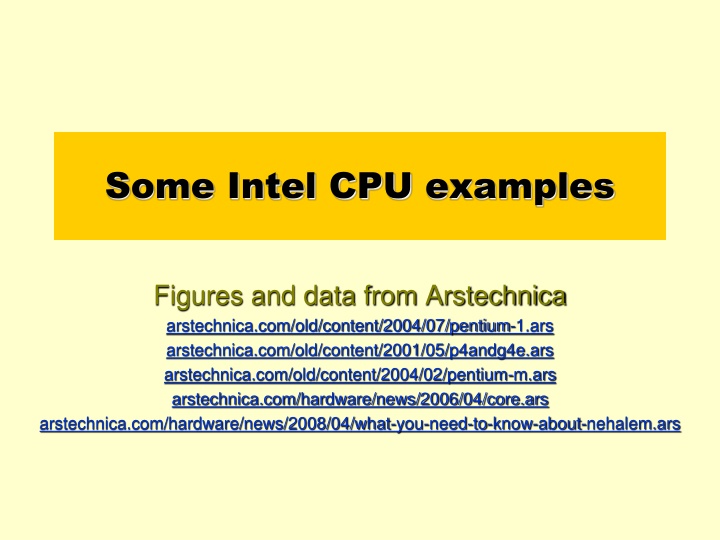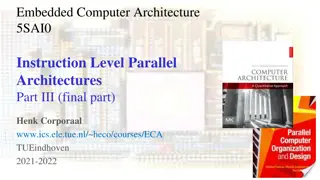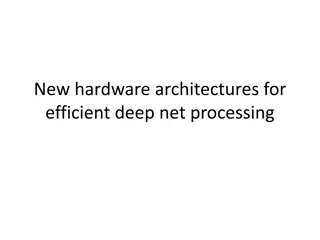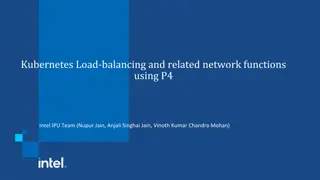Intel CPU Architectures Overview: Evolution and Features
Explore the evolution and key features of various Intel CPU architectures including Pentium, Core, and Pentium 4 series. Learn about the pipeline stages, instruction issue capabilities, branch prediction mechanisms, cache designs, and memory speculation techniques employed in these processors. Gain insights into the advancements in CPU microarchitecture over the years.
Download Presentation

Please find below an Image/Link to download the presentation.
The content on the website is provided AS IS for your information and personal use only. It may not be sold, licensed, or shared on other websites without obtaining consent from the author.If you encounter any issues during the download, it is possible that the publisher has removed the file from their server.
You are allowed to download the files provided on this website for personal or commercial use, subject to the condition that they are used lawfully. All files are the property of their respective owners.
The content on the website is provided AS IS for your information and personal use only. It may not be sold, licensed, or shared on other websites without obtaining consent from the author.
E N D
Presentation Transcript
Some Intel CPU examples Figures and data from Arstechnica arstechnica.com/old/content/2004/07/pentium-1.ars arstechnica.com/old/content/2001/05/p4andg4e.ars arstechnica.com/old/content/2004/02/pentium-m.ars arstechnica.com/hardware/news/2006/04/core.ars arstechnica.com/hardware/news/2008/04/what-you-need-to-know-about-nehalem.ars
2 Pentium Dual Issue Two 5-stage integer pipes (some restrictions) 1: Prefetch/fetch 2: Decode 1 Branch predict (75%) 3: Decode 2 Address computation 4: Execute 5: Write back 6-stage float pipe
3 Pentium Pro, II, III 3 instruction issue 2 simple, 1 complex 40-entry ROB Rotating queue Execution 5 issue ports Store addr/data 1 cycle EX for most * 4-cycle latency, 1 cycle issue
4 Pentium Pro, II, III 12-stage pipe 1-4.5: BTB & IF Prediction 90+% 4.5-6: Decode 7: ROB rename 8: Write RS (20 inst.) 9: Issue 10: Execute 11-12: Retire
5 P4 (Pentium 4) Trace cache Internal RISC ISA 90% Hit rate ROM for long instructions Mini BTB for trace cache branches 20+ stage pipeline More on trace cache miss
6 P4 (Pentium 4) 1-2: Trace cache next IP 3-4: Trace cache fetch 5: Drive signals 6-8: Allocate & Rename 128 reg 9: Queue 10-12: Schedule 13-14: Dispatch Up to 6 per cycle 15-16: Register file 17: Execute 18: Flags 19: Branch check 20: Drive signals
7 Pentium M Branch prediction 4k BTB Loop predictor Indirect predictor op fusion Avoid ROB
8 Core 96 entry
9 Core Decode 4-7 issue to 7 op Multiple x86 to one op Macro-fusion merges across x86 ops op fusion to avoid ROB
10 Memory Speculation store A, addr1 -stall- load addr2, B -stall- add B,C,D load addr2, B store A, add1 add B,C,D If addr1 = addr2 Aliasing If addr1 addr2 Assume no aliasing Restart if wrong
11 Nehalem Rely on hyperthreading 128-entry ROB 36-entry RS























